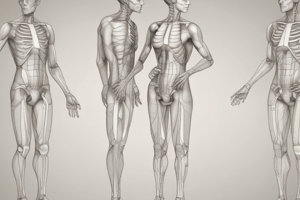Podcast
Questions and Answers
Which muscle is difficult to palpate and may require the patient to perform a palmar pinch for its location?
Which muscle is difficult to palpate and may require the patient to perform a palmar pinch for its location?
- Flexor pollicis longus
- Adductor pollicis (correct)
- Extensor pollicis longus
- Flexor pollicis brevis
What muscle may attempt to substitute for the thumb adductor, resulting in extension of the CM C joint?
What muscle may attempt to substitute for the thumb adductor, resulting in extension of the CM C joint?
- Extensor pollicis longus (correct)
- Abductor pollicis brevis
- Flexor pollicis brevis
- Flexor pollicis longus
Which muscle is located between the first dorsal interosseus and the first metacarpal bone?
Which muscle is located between the first dorsal interosseus and the first metacarpal bone?
- Opponens pollicis
- Abductor pollicis brevis
- Opponens digiti minimi
- Adductor pollicis (correct)
In opposition (thumb to little finger) range of motion, which muscle is responsible for flattening the palm during medial rotation?
In opposition (thumb to little finger) range of motion, which muscle is responsible for flattening the palm during medial rotation?
Where should the therapist apply resistance for the opponens pollicis during the examination of opposition range of motion?
Where should the therapist apply resistance for the opponens pollicis during the examination of opposition range of motion?
In which grade would a patient be if they were able to move their thumb towards their body with no resistance?
In which grade would a patient be if they were able to move their thumb towards their body with no resistance?
If a patient tolerates moderate resistance while moving their thumb vertically until it points to the ceiling, what grade would they be assigned?
If a patient tolerates moderate resistance while moving their thumb vertically until it points to the ceiling, what grade would they be assigned?
What is the grade assigned to a patient who completes partial range of motion when asked to move their thumb towards their index finger?
What is the grade assigned to a patient who completes partial range of motion when asked to move their thumb towards their index finger?
If a patient exhibits no contractile activity when asked to move their thumb towards their index finger, what grade would be assigned to them?
If a patient exhibits no contractile activity when asked to move their thumb towards their index finger, what grade would be assigned to them?
Which grade would be assigned if a patient completes the full range of thumb adduction motion with maximal finger resistance?
Which grade would be assigned if a patient completes the full range of thumb adduction motion with maximal finger resistance?
What is the prime mover for finger metacarpophalangeal (MP) flexion?
What is the prime mover for finger metacarpophalangeal (MP) flexion?
For finger MP flexion, which muscle may attempt to substitute for the lumbricales, resulting in a pattern to be avoided?
For finger MP flexion, which muscle may attempt to substitute for the lumbricales, resulting in a pattern to be avoided?
Which muscle is responsible for flattening the palm during medial rotation in thumb opposition (thumb to little finger) range of motion?
Which muscle is responsible for flattening the palm during medial rotation in thumb opposition (thumb to little finger) range of motion?
Where should the therapist apply resistance for the examination of thumb opposition range of motion?
Where should the therapist apply resistance for the examination of thumb opposition range of motion?
Which muscle is located between the first dorsal interosseus and the first metacarpal bone?
Which muscle is located between the first dorsal interosseus and the first metacarpal bone?
Which muscle is primarily responsible for flexion of the proximal interphalangeal (PIP) joint of the fingers?
Which muscle is primarily responsible for flexion of the proximal interphalangeal (PIP) joint of the fingers?
During the PIP test for the flexor digitorum superficialis, what is the major substitution for this motion if the distal interphalangeal (DIP) joint is allowed to flex?
During the PIP test for the flexor digitorum superficialis, what is the major substitution for this motion if the distal interphalangeal (DIP) joint is allowed to flex?
What is the position of the forearm during the DIP test for the flexor digitorum profundus to eliminate the influence of gravity?
What is the position of the forearm during the DIP test for the flexor digitorum profundus to eliminate the influence of gravity?
Which muscle is a prime mover for finger abduction range of motion?
Which muscle is a prime mover for finger abduction range of motion?
Where should the resistance be applied while testing the extensor indicis during finger metacarpophalangeal (MP) extension range of motion?
Where should the resistance be applied while testing the extensor indicis during finger metacarpophalangeal (MP) extension range of motion?





